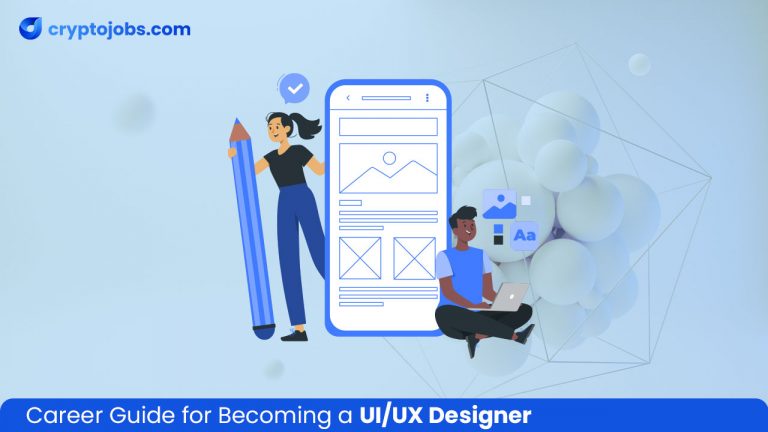
Career Guide for Becoming a UI/UX Designer
- cryptojobs.com
- February 14, 2024
- All Posts, Career Guide
- 0 Comments
UI/UX design is becoming imperative and an essential role in the Web3 industry. The key to a successful website or product lies in the hands of these designers. Both UI (User Interface) and UX (User Experience) are vital in making sure the result looks good and is easy to use. The UI/UX designers breathe life into projects and ensure that the interfaces are responsive and would be loved by the target audience.
If you think a career in UI/UX design suits you but you’re not sure where to begin, we’ve got you covered. Here are eight simple steps to guide you on how to become a UI/UX designer in 2024.
Step-by-step Guide on Starting a Career as a UI/UX Designer
Given the highly important role UI/UX designers play in Web3 development, it is no surprise that recruiters are very picky about the candidates they choose for these positions. It is one the most lucrative career options in the Web3 industry that you can easily dive into, provided you follow these steps.
Step 1: Gain Basic Knowledge in UI/UX
If you still believe that UX and UI designers only create products to improve their appearance, research the several disciplines under this umbrella.
You will be surprised to find out how multifaceted the nature of a UI/UX designer’s job is. There are many ways to expand your knowledge on this topic, from books, podcasts, online courses, and university degrees; the options are vast.
Step 2: Get Familiar with UI/UX Principals
User-centric design is the foundation of UX design. Every guideline and recommended procedure you come across is based on this core idea. Prioritizing the user, creating designs with actual people in mind, and making decisions based on their requirements rather than assumptions are all examples of user-centric design.
You may like to know about How Much Does a UI/UX Designer Earn
One of the main responsibilities of a UX designer is to satisfy stakeholders while speaking out to consumers. This means getting to know your target audience, learning about their wants and expectations, and developing technically sound, approachable solutions that fit your budget and company objectives.
Step 3: Understand the Phases of UI/UX Design
The UX design process involves four main phases: research, design, testing, and implementation.
In the research phase, project goals and requirements are defined by understanding target users, their needs, and project limitations through collaboration with stakeholders. The design phase transforms solutions into tangible artifacts like wireframes, evolving into high-fidelity prototypes.
Testing involves user testing to identify and address usability issues before market release. The final implementation phase includes handing designs to developers for coding and creating a fully functional product.
Step 5: Practice What You Learn
It is essential to apply what you are learning if you want to work as a UI/UX designer. Aside from your coursework, having additional design experience is beneficial.
Unless you are lucky enough to get a paying customer while you are still studying, the secret to getting practical experience is to be proactive and inventive. The following two tactics can help you get started with design:
- Apply UI/UX design to your existing employment (see a possible difficulty in your present workplace and try to fix it using UI/UX methodology)
- Do a voluntary redesign for the sake of practice without being asked for it (you can volunteer your design skills to small-scale NGOs and community platforms).
Step 6: Create a Portfolio
In the world of UI/UX design, words alone will not land you a gig; you need to prove that you possess the right skills for the job, and what better way to do this than having a portfolio?
You may like to know about Challenges and Opportunities for UX Designers in 2024
As mentioned previously, UI/UX design is a multifaceted role with multiple disciplines; it is important to remember them when designing your portfolio for a project. Submitting a portfolio that does not meet the project’s skill and design requirements will only lead to rejection.
Step 7: Don’t Be Afraid to Ask for Help
Many people make it a habit of not seeking help when stuck on what the next step should be. A career change or even choosing the right career is a major life event that requires mentorship from experts within the field.
Learn to be more open to seeking help and advice where needed, as this will help you immensely when you need to reach out.
Choose the Right Job Board
You have done your research, practiced your skills, and crafted the perfect portfolio known to man, but what use is this when you do not know where to find opportunities within your line of work?
This is where extensive knowledge of various job application channels proves beneficial. You can go the traditional route and apply via a career fair, take the long route by applying to openings on the company website’s careers page, or be smart and target UI/UX designer-specific job boards.
Take the final step by choosing the right Web3 job board. Let cryptojobs.com be your gateway to a plethora of opportunities tailored for UI/UX designers like you.




